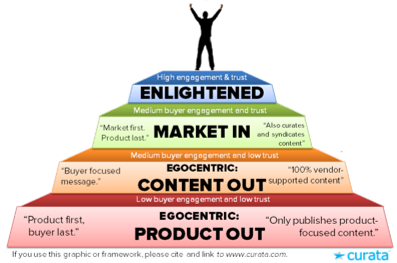- Share The 4 Steps to Content Marketing Enlightenment on Facebook
- Share The 4 Steps to Content Marketing Enlightenment on Twitter
- Share The 4 Steps to Content Marketing Enlightenment on Linkedin
- Share The 4 Steps to Content Marketing Enlightenment via email
This post has been updated as of March 20, 2014 due to the release of our eBook, The 4 Steps to Content Marketing Enlightenment. Our most recent survey found that 71% of marketers are increasing their content spend this year to hire staff, create more content and better leverage content-specific technology. However, few of these marketers will be able to overcome the content shock that many of their buyers experience due to the overwhelming amount of information available on the Internet today.
Due to this significant concern, we’ve crafted The 4 Steps to Content Marketing Enlightenment eBook to help content marketers overcome challenges and cut through the noise. These challenges include: calibrating the goals of content before you publish, adding your own insights to content like an industry analyst, curating the highest quality content for readers and tapping into the power of content technology.
In the weeks following Content Marketing World 2013, we found that our “STOP Egocentric Content Marketing” message was resonating with content marketers far and wide. The essence of the campaign is that while many of us have jumped on the content marketing bandwagon these days, providing content of value to our buyers, most of us are still communicating to our audience in our voice only. We are striving to be the sole source of insight and knowledge without much regard for what’s happening outside of our own domain, not to mention the fact that our audience wants to hear from other sources and perspectives.
In order to progress beyond egocentric content marketing, I have outlined below the 4 Steps to Content Marketing Enlightenment. This model mimics Steve Blanks’ now famous 4 Steps to Epiphany. Using this framework, you can gauge where you currently stand from a content strategy perspective, and identify the steps you need to better engage with your audience and increase marketing’s overall impact on your organization.
Step 1 – Egocentric: Product Out
Marketers at the Egocentric: Product Out stage have certainly bought into content marketing. Unlike some of their peers who are still solely fiddling with interrupt driven, outbound marketing, these marketers do understand the value and merits of producing and publishing their own content to attract buyers to their brands. However, marketers at this step just don’t quite understand how to get their content marketing to work. Their understanding of content marketing is superficial, and in many ways, naive. They hope that “if you publish it, they will come.”
Egocentric, product-out marketers will publish any content that they have readily available. They may turn a product capabilities datasheet, that they had already created for the sales team, into a blog post. Or they may place a lead capture form in front of a sales presentation in hopes of generating a few more leads. Rather than creating new content, they often inappropriately repurpose product-centric content that had been designed for the lower funnel, for the top of the funnel.
Some telltale signs of an egocentric, product out strategy include:
- All content that they produce mentions their products or services
- They have very low subscriber rates
- Readers are not linking to their content (unless they have a direct interest in the product, i.e. resellers)
Even though these marketers have the best intentions, they don’t receive good results.
Step 2 – Egocentric: Content Out
On the next step are Egocentric: Content-Out marketers. These marketers realize the value of content marketing similar to those on step 1; but in addition, they realize that the content they produce must be focused on buyers’ interests versus their own vendor offerings.
Marketers on this step will create original content with their buyers in mind, rather than starting with their product or solution. They may employ some of the following content marketing best practices:
- Using personas to map out created content for specific buyer profiles and market segments. (i.e., based upon market analysis, voice of the customer interviews, etc.)
- Querying their sales team for questions asked by buyers as starting points for content creation.
Using techniques like these, marketers can tune in on buyers’ greatest interests (e.g., related to their own company, market and/or professional career) to create more compelling content, rather than solely talking about their own product or solution.
While these marketers create content with their buyers in mind, it is still solely sourced from the vendor. Types of problems that arise from this are:
- Created content only; which provides little outside perspective for readers
- Promotional Interactions; meaning that comments on other parties’ blog posts or forums have very little value add and are aimed at getting viewers to click on links to their own content instead of fueling conversations
Egocentric, content out marketers are able to achieve a bit of engagement, but very little trust in the marketplace. These marketers are often guilty of a “content surge” where they double down and increase of the quantity of content (not necessarily the quality) in hopes of reaching readers. This typically has diminishing returns as their more prominent issue is getting buyers to trust their brand, which can be done by publishing a variety of content from credible sources.
Step 3: Market In
In addition to all the realizations that the predecessors on lower rungs have, Market In marketers also realize they need to incorporate other voices into their content marketing campaigns to sustain their engagement and increase their perception as a trusted source.
These marketing professionals may use some of the following tactics to bring the market voices into their content:
- Regularly curate third party content from a wide variety of sources. Buyers seek out content from peers (other buyers), experts (analysts & trade pubs), and vendors during the buying process.(refer to above figure) Market In marketers will actively seek out content from other vendors, peers, and experts to provide a one-stop knowledge shop for buyers.
- Listen & Follow. Rather than relying solely on internal sources such as their sales team for content ideas, these marketers will go outside of their organization for content ideas and spend a considerable amount of time listening to what the outside world is saying. This increases their ability to provide higher quality and more relevant content to their audience.
- Value added interactions. Because these marketers are tuned in to the market, they are able to identify relevant conversation on other sites, as well as add value through comments in those discussions. These actions not only make these marketers smarter, but it increases the value that they provide other parties, which ultimately results in reciprocation of interest and traffic.
- Content Marketing Teams. Enlightened marketers understand that content is not a part-time job. Content teams led by a content marketing executive (Chief Content Officer, VP, Director of Content) consist of a content manager, specialist and a team of writers who are able to craft strong storytelling narratives.
These marketers are able to drive engagement as well as trust. However, they need to overcome a few more challenges to attain enlightenment. These include:
- Lack of differentiation in content, as many times these marketers are simply regurgitation third-party content and perspectives
- Failing to capitalize on the industry following they build by not marketing their own marketing
Best-in-class marketers at this stage will realize that there is room for improvement here, especially if their organization is facing pressure to create more compelling and valuable content due to competitors in the marketplace.
Step 4: Enlightenment
Enlightened marketers are at the pinnacle of the content market path of realizations. Some of the final realizations they make are:
- Think like an industry analyst by bringing independent viewpoints to the table, performing primary research on relevant topics and driving intellectual content and conversations.
- Calibrate the goals of content before it’s published to determine its intent and make sure it’s aligned with a larger content initiative (make sure it’s engaging for your audience, too).
- Be selective when it comes to curation to make sure you’re providing the most relevant, valuable information for readers. Focus on quality, not quantity when it comes to content.
- Use ethical best practices when curating content from third-party sources, including annotation (to provide added value readers) and clear attribution to the original author with a link back to the article featured in your curated post.
- Implement content-specific technology to manage your content workflow and avoid the “duct-tape” trap of using too many applications with highly manual cut and paste tactics to leverage content marketing.
- Measure the impact of content so you understand what content resonates with readers and what content falls flat; and market you marketing by repurposing content to get the most mileage out of it.
Enlightened marketers are able to attain both high buyer engagement and trust and become the go-to destination for their audiences. Though it may not be the enlightened marketer’s intent, they may eventually serve as a vendor voice, a forum for peer/user discussions, and as an industry expert themselves. Over time, buyers may even solely rely on the enlightened marketer’s content as the starting and ending points for their journey.
To read more about how you can start on your path to content marketing enlightenment, download our latest eBook The 4 Steps to Content Marketing Enlightenment and request a free demo of Curata’s content marketing solution.
The following resources provide more tactical insight to help you progress to the step of Enlightened Content Marketer from a content strategy perspective:
- Content Marketing Tactics Planner: Find out how to shape up your marketing mix to become the best-in-class standard of 65% created, 25% curated and 10% syndicated.
- 5 Simple Steps to Becoming a Content Curation Rockstar
- Content Curation Look Book: Collection of enlightened companies tapping into the power of curation (e.g., Intel, Adobe, IBM, Oregon Wine Board)









